The defeat of Austria-Hungary in the 1914 Serbian campaign of the year. Battles on the river. To the nucleus and at the Mine
The 1914 campaign on the Serbian front, despite the superiority of the Austro-Hungarian troops, ended in victory for the Serbian army. The activity and determination of the Serbian army allowed the Serbian command to achieve decisive success over the Austro-Hungarian armies. After this, the Austro-Hungarian troops did not dare, without the help of the Germans and Bulgarians, to launch a new offensive until the deep autumn of 1915. With this, Serbia supported the Russian Empire, diverting to its front two Austro-Hungarian armies, which could, at a crucial moment, strengthen the Central Powers on the Eastern (Russian) front.
The first invasion of the Austro-Hungarian armies. The victory of the Serbs on the river. The nucleus
Since the declaration of war on July 28, 1914, the Austro-Hungarian siege artillery, which was located on the northern bank of the Danube, and the art of the Danube flotilla began the bombing of Belgrade. After that, the Austro-Hungarian troops carried out a series of demonstrative crossings in some sections of the Danube and the Sava, trying to create the impression of a decisive attack in this direction and forged the Serbian forces.
31 July Austria-Hungary announced a general mobilization. August 4 Serbian regent Alexander issued an order for the army, where he declared war on Austria-Hungary. The order referred to the Austro-Hungarian Empire as the eternal enemy of Serbia, the need to liberate the Slav brothers in Srem, Vojvodina, Bosnia and Herzegovina, Slavonia, Banat, Croatia, Slovenia and Dalmatia. In addition, it was reported that behind Serbia is its patroness Russia with its allies France and Britain.
12 August 200-th. The Austro-Hungarian army launched a general offensive. In the morning, the 4 Austro-Hungarian Corps forced Sava above Shabac; The 8 and 13 corps built crossings over the Drina River at Belina, Leshnitsa, Loznitsa; The 15 Corps was shipped across the Drina at Zvornik and Lyubov. Austro-Hungarian forces advanced from the northwest and west to the east on a broad front from Sabac to Lyubovya.
The Serbian command refused to defend Belgrade, transferred the capital to Niš and, holding back the enemy with cover units, deployed two armies - the 2 and 3 to the Drinsky front. First came a separate cavalry division. It was followed by the remaining divisions of the maneuverable group. The Serbs launched a counter-offensive and rather quickly reached the valley of the Drina River, while the Austro-Hungarian troops slowly forced this water barrier.
The Austro-Hungarian troops lost the surprise factor, losing the 4 of the day to forcing water obstacles, crossing the troops, setting up fortifications on the coast, fixing on the heights commanding the right bank of the r. Driny, on the occupation of Sabac and overcoming the rather weak resistance of the Serbian parts of the cover. Already on August 16, the advance units of the Serbian armies started fighting with the enemy on the line from Šabac on the right flank, to Pechka, on the left.
The terrain on which the battle began was divided into two zones: in the north there was the Machva valley, in the south there was a mountain range, from it to the river Drina perpendicular to its flow are the mountain spurs Cher (Tser), Iverah, Guchevo, separated from each other by tributaries this river, the main of which are the rivers Yadar and Leshnitsa.
15 August The 4 th Austro-Hungarian corps occupied the district of Sabac. The 8 corps was divided into three columns: the left through the Machva valley advanced on Slatina, the central one moved along the Cher and the right spur up the valley. Leshnitsy. The 13 Corps from the Loznitsa region attacked in two columns on both sides of the r. Yadar. 15-th corps attacked Krubanie and Oven.
The Serbian cavalry division, reinforced by infantry and artillery, passed through Slatina and overturned the left column of the 8 corps. The Austrians were driven back to the river Drina. This battle was of great importance, as it separated the forces of the 4 corps concentrated in Šabac from the Austro-Hungarian troops, which were advancing in the mountainous region. Soon the divisions of 2 of the Serbian army of General Stefanovic approached. The right wing of the army (two divisions) began the battle against the 4 corps of the enemy, and the left wing (the other two divisions) advanced along the spurs of Cher and Iverakh on Leshnitsa. As a result, the Serbian forces bound the enemy with battle, and the Austro-Hungarian command was forced to suspend the offensive.
At the same time, units of the 3 Serbian army of General Juriska Sturm attacked the enemy's 13 corps in the valley of the Yadar river. However, due to the enemy’s significant superiority, they were forced to retreat. On the left flank of the 3 Army, the mountain brigades of the 15 Austrian Corps also continued to push the Serbs and rejected parts of the third call for Kruvanie and Oven. As a result, the Serbs had to retreat on the left wing of the Drin front.
17 August fights continued. Serbian armies were reinforced by units that did not have time to go to the battle site of August 16. This allowed the divisions of the 2 Army to go on the offensive and develop their first successes. Serbian troops seized the first two ledges of the Cher ridge from the enemy. August 18 Serbian troops, having beaten off enemy counterattacks, captured all the peaks of the Cher ridge. As a result, the front of the enemy was broken, the Austro-Hungarian army group was finally dissected and success on the flanks did not matter. On August 19, the left flank of the 2 Serbian army cleared the entire Iverah ridge from the enemy. Having lost the Cher and Iverah ranges, the Austrians lost the ability to effectively defend themselves and cleared the valley of the river Leshnitsa.
By 19 in August, the connections of the 3 Serbian army were able to stop the offensive of the 13 and 15 corps supported by parts of the 16 corps, and advanced in the directions to Jarebice and Kruppanie. The Austro-Hungarian troops suffered heavy losses and began to retreat along the entire front. 20 August the Serbs moved to the pursuit of the enemy. In some areas, the Austrian troops continued to fight fiercely, but in most areas the retreat began to escalate into indiscriminate flight.
4 th Austro-Hungarian corps tried to reverse the situation and struck a strong counter-attack. Austro-Hungarian troops achieved some success and pushed the Serbs back across the river. Dubrava. However, after the 4 days of fierce fighting, the 2-I Serbian army rejected the enemy. As a result, by August 24, the Austro-Hungarian corps were thrown back to their original positions, the Sava and Drina rivers.
The Serbs captured 50 thousands of prisoners, 50 guns, 150 charging crates, a large number of guns, various combat and food stocks.
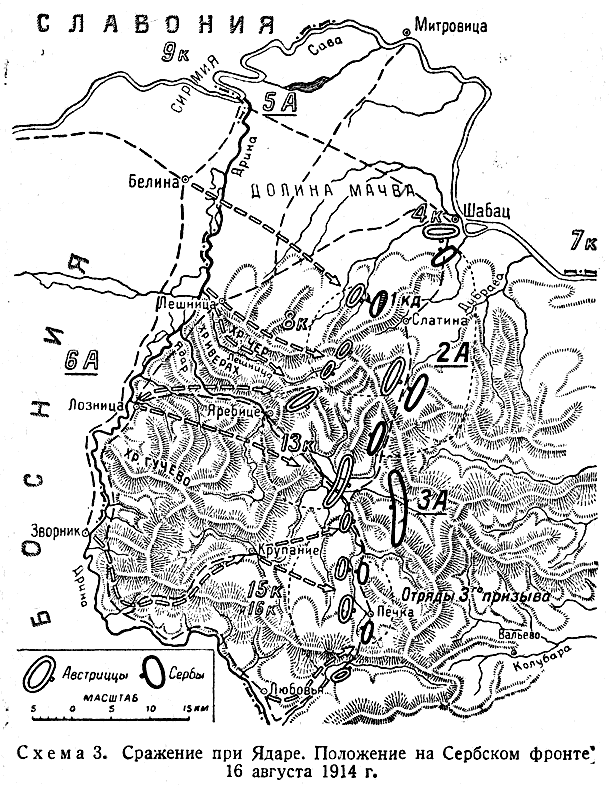
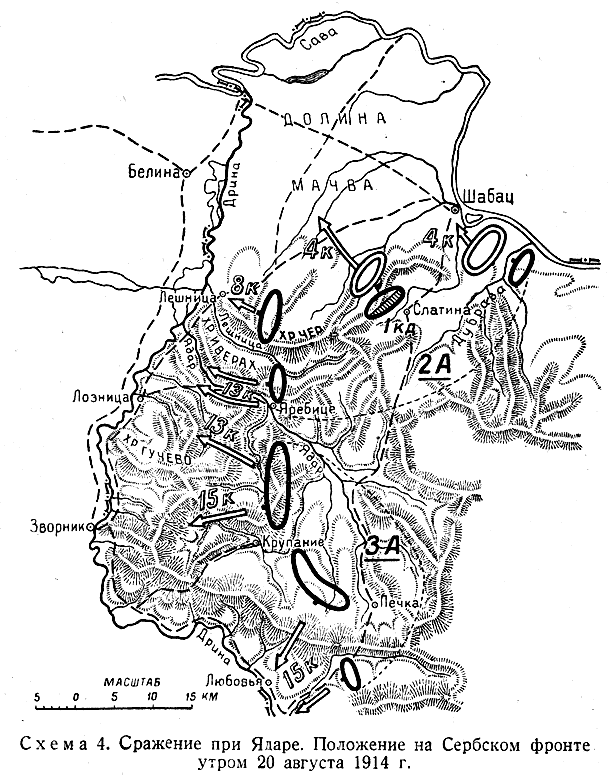
Battle of the Yadar. Source: Korsun N. G. Balkan Front of World War
Results
The battle on Yadar ended with a complete victory for the Serbian army. The plans of the Austro-Hungarian command for the "quick war" and the defeat of Serbia were thwarted by the formation and timely transfer of a maneuverable group (divisions of the 2 and 3 of the Serbian armies). The Serbian army, having small cavalry and artillery, turned out to be more skillful in the mountain war. The Austro-Hungarian command dispersed their forces and the separately acting corps were defeated.
It should not be forgotten that the Austro-Hungarian command was forced to cut the army group almost in half - from 400 thousand to 200 thousand soldiers, transferring the most powerful 2 army (190 thousand bayonets) from Sava and Danube to Berlin Eastern Galicia, on the Russian front. If Austria-Hungary had launched an offensive as originally planned - two strike forces from the north — Belgrade and west — Drinskoe, and thousands of soldiers in 400, the situation could turn into a defeat or severe exhaustion for the Serbs, where the Austro-Hungarian troops had full advantage in people, artillery and military resources.
This victory was of strategic importance. During the period of decisive operations in Galicia, the Serbian army not only bound the enemy, but also caused serious damage to the Austro-Hungarian troops. This defeat strongly affected the morale of the Austro-Hungarian army, and caused damage to the prestige of the Austro-Hungarian Empire.
The second attack of the Austro-Hungarian armies on the Balkan front. Mine Battle
The Austro-Hungarian command carried out a regrouping of forces and was preparing for a new strike. Serbian command decided to preempt the enemy. In early September, 1914, the Serbian forces launched an offensive on both their flanks. The right flank of the Serbian army forced Sava in several places and occupied Mitrovica. However, the counterattack of the Austro-Hungarian corps forced the Serbian troops to return to their original positions. Serbs suffered significant losses. The same thing happened when the Serbs seized 10 September Zemlin.
On the left flank, the Serb-Montenegrin troops pressed the right flank of the 15 corps and the 16 corps and tried to organize an offensive on the Sarajevo area. But the start of the second offensive of the Austro-Hungarian armies on the Serbian front forced the Serbian command to transfer part of the troops from the left flank to support the main forces.
By September 7, the Austro-Hungarian command completed the regrouping of forces. The events on the Russian front absorbed the troops of the 4 corps, half of the 7 corps and one division of the 9 corps. These troops had to be replaced by units transferred from the inner regions of the Austro-Hungarian Empire and units from the Italian border. These troops replaced the 16 Corps and the right flank of the 15 Corps on the Montenegrin Front, which moved northward, extending the Drinsky Front. Between Mitrovica and Belina, the Austrian troops (8, 9) were to make a vigorous demonstration, holding down enemy troops. The 15 and 16 corps attacked in the area of Zvornik and Lyubovya in the direction of the Kruphanie-Pech area. Both groups linked the 13 body. The commander of the Austro-Hungarian forces, Potiorek, planned to bypass the left flank of the Serbian army, quickly advance to Valjevo and cut off the withdrawal paths of the rest of the enemy army.
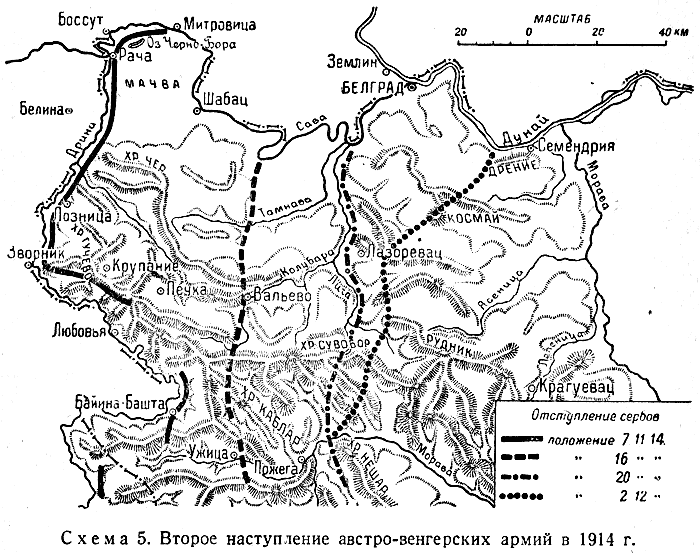
On the night of 7 on September 8, parts of the 8 and 9 blocks tried to force the Sava at Mitrovica and Raci, but were rejected by Serbian troops. The 9 corps units still managed to break into the Machva valley, but the Serbs received reinforcements and repulsed the attack. On the night of 8 on September 9, the Austro-Hungarian forces again crossed the river. One of the divisions of the 8 Corps fought all day long in the vicinity of the Black-Bora Lake, but could not withstand the Serbian counter-offensive and again retreated across the river. During the indiscriminate crossing, the bridge was clogged and the Austrian rear guard was destroyed by Serbian troops. As a result, the crossing of the northern group of the Austro-Hungarian army group failed.
In the southern sector, the advance of the Austrian troops developed more successfully. In the area of Lyubov, Austrian mountain troops were able to 7 September to gain a foothold on the ridge of the right bank of the r. Driny Soon the Austrian troops reached the bottom of the Gučevo ridge, the Krupanie plateau and the Stove. But then the advance of the Austro-Hungarian army stalled. The Austrians could not achieve decisive success in two months (until the beginning of November). Both sides tried unsuccessfully to overthrow the enemy: the Austrians tried to overthrow the Serbs from the heights of Gučevo, and the Serbian troops ñ to throw the enemy over the Drina.
However, at this time the position of the Serbian army began to deteriorate due to a lack of artillery ammunition. The pre-war reserves were exhausted, and the new revenues were not enough for such intense battles. There was also a shortage of other weapons, ammunition. Two Austro-Hungarian corps received reinforcements, captured the heights on Gučevo and began to push the Serbs. Serbian troops were under threat of coverage of the right flank, and moved to new positions. In this case, the Serbs organized strong counterattacks, held the enemy at a considerable distance. The Serbian army in an orderly manner has moved to a new line of defense.
14 November Austro-Hungarian troops occupied Valjevo. The Austrian attack was accompanied by the burning of Serb villages and violence against civilians. In the same period, the Austro-Hungarian command attempted to carry out an offensive operation in the north, at Semendrii. Here, six battalions transported across the river. Danube. However, they were completely destroyed.
From 16 to 20 in November, Serbian troops occupied defenses on the frontiers: p. Kolubara, its tributary League, the Suvobor massif, Kablar and Neshar ridges, between which the waters of the Upper Morava flowed. The left flank was held by General Bojovic's 1-I army transferred from the Belgrade region, the center was General Yurishich-Shturm's 3-I army, and Stefanovic's 2-I army was in the right flank.
The Austro-Hungarian command struck the 2 army with 8 units and the newly formed 17 corps, the 3 army attacked parts of the 13 and 15 corps, the 1 army - troops of the 16 corps (they attacked in the area of the Suvobor massif and in the direction of Pozhegi). The most severe blow was struck on the left flank. Austrian troops captured Suvobor. The Serbian command was forced to pull off the troops on the right flank and leave the capital. December 2 The 1914 of the year’s front ran between the Danube and the headwaters of the Morava River along the heights of Dreniy, Kosmay, Lazorevac and the western slope of the Rudnik plateau.
The Austrian 5 Army enters Belgrade. 5 December 1914 of the year
The Austrian command, having occupied Belgrade, decided that victory was close and the Serbian army was no longer capable of serious resistance. However, the Austrians miscalculated. Serbs helped allies. At this time, Serbia received guns and ammunition from the port of Thessaloniki from France. And along the Danube to the pier of Prakhov, military and food aid from the Russian Empire was organized. In addition, 1400 students arrived from students who completed two-month courses, they became non-commissioned officers in companies, strengthening command. This allowed the Serbian command to restore the strike power of the army and go on to the counteroffensive. Moreover, it was impossible to retreat further. The loss of Kragujevac - the most important industrial and military center, threatened with complete defeat.
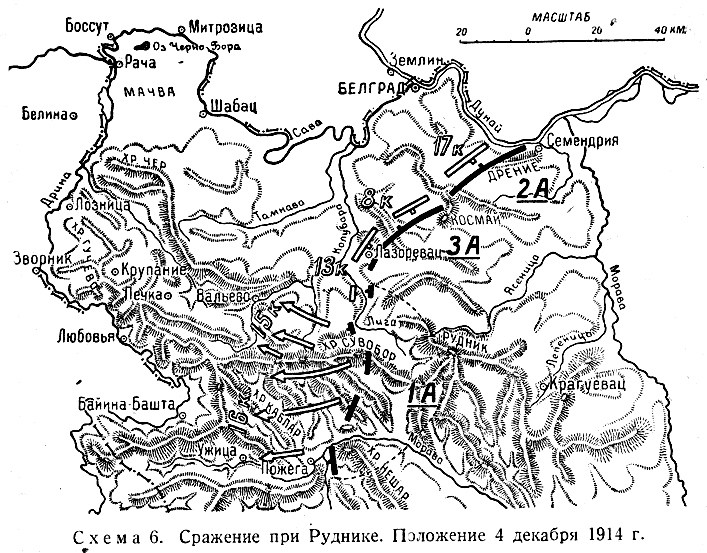
They decided to strike the main blow on the left flank. The commander of the 1 Army, General Misic (he replaced Bojovic) got the left flank to strike Pozeg, and the center and the right flank - on the Suvobor massif. Suvorob ordered to take at any cost. The 2 and 3 armies were supposed to support this offensive.
On the morning of December 3, Serb forces launched a counteroffensive in the mine area. The morning fog hid the movements of the Serbian troops. The Austrian column was rather carelessly descending from the Suvoobor massif. The fire of the Serbian artillery and the unexpected attack led to the complete defeat of the Austrian column, which did not have time to turn into battle formation. However, on the heights of five Austrian brigades, they fought fiercely for three days, repelling Serb attacks. It was not until the afternoon of December 5 that the Austro-Hungarian troops began to retreat. The remnants of the 16 corps retreated to the horn and beyond. The rest of the Austrian corps also suffered a defeat.
The army of Mišić, ignoring his right flank, pursued the troops of the 16, 15, and right flank of the 13 corps to the Drina River. The Austro-Hungarian command was unable to timely transfer the army reserves to deter the Serb offensive. Austro-Hungarian troops fled, throwing artillery, weapon, carts, warehouses, etc.
When the success of the 1 army was evident, the troops of the 2 and 3 armies attacked the enemy on the front from Drone to Azorevac. Austrian 17 units, 8 units and parts of the 13 units tried to counterattack, but were pushed into position south of Belgrade. On December 13, their resistance was finally broken and the Austro-Hungarian forces were again driven back to their territory.
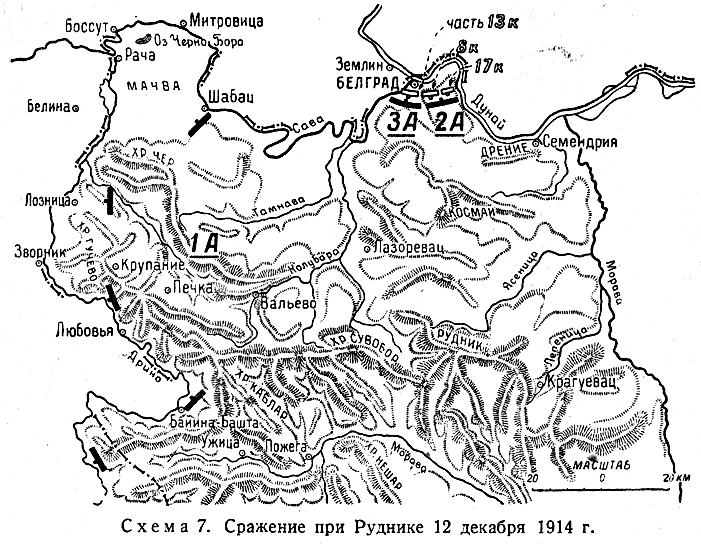
Results
December 15 Serbian troops liberated Belgrade and finally cleared Serbia of the enemy forces. The Austro-Hungarian army lost 46 to thousands of prisoners, 126 guns, 70 machine guns, 362 charging boxes, large stocks of ammunition, supplies and various items.
However, the Serbian troops were exhausted and exhausted by a hard battle. They could not develop success and complete the defeat of the Austro-Hungarian army. Serbian army again stopped at the boundaries of the river. Sava and r. Driny There were no reserves for further offensive.
After two defeats in 1914, the Austro-Hungarian command for a long time abandoned offensive action. Two corps were left to defend the borders. The rest of the troops transferred to the defense of the Carpathians. In addition, in May 1915, Italy declared war on Austria-Hungary, it distracted Vienna from Serbia.
In general, it was a sensitive defeat for Austria-Hungary. Germany and Austria-Hungary could not break through the passage to connect with the Allied Ottoman Empire.
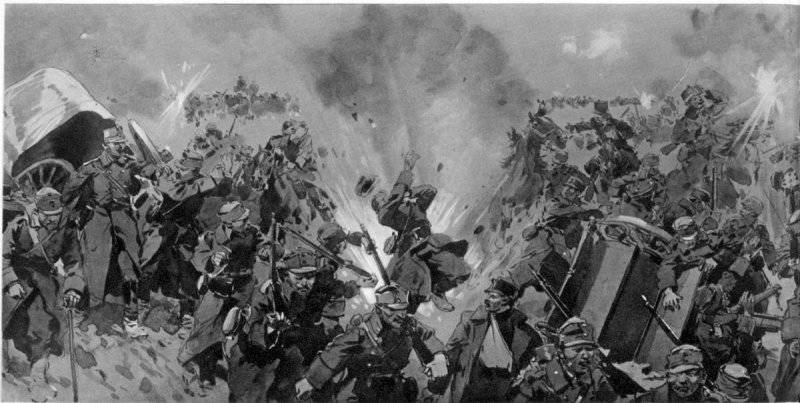
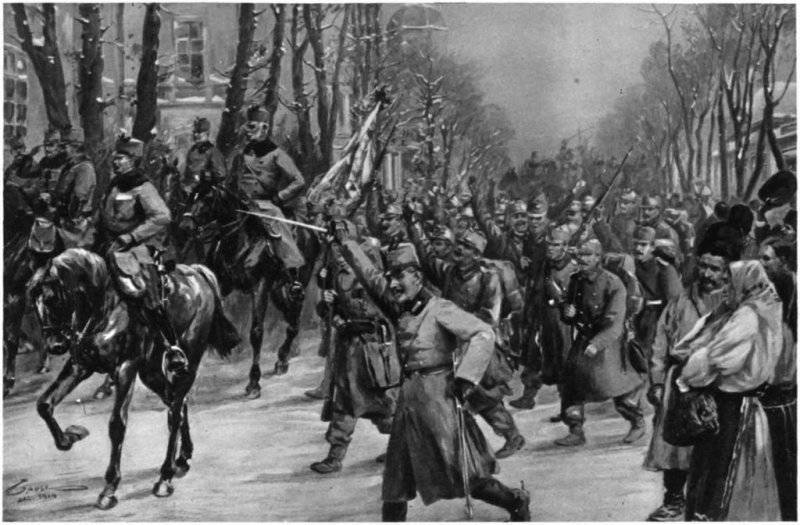
Information